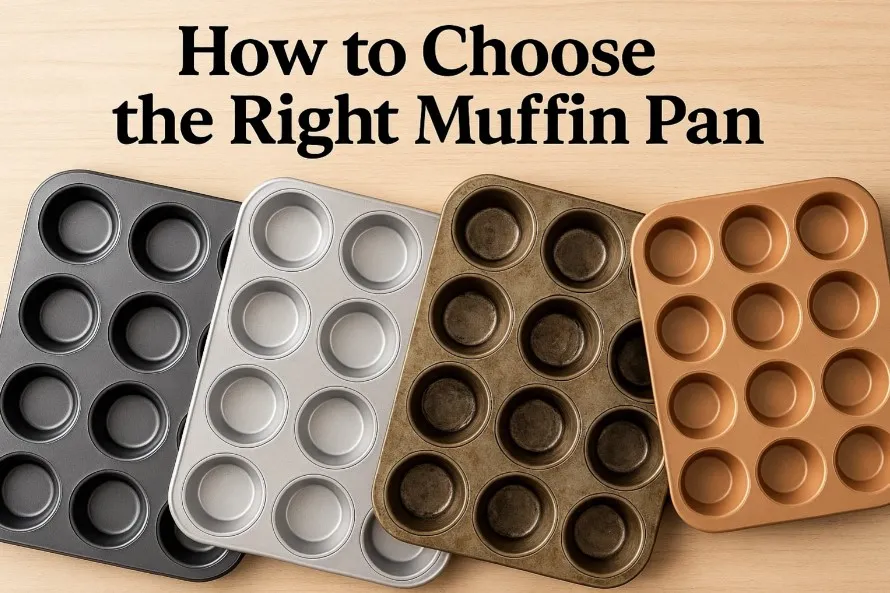Choose a non-stick, heavy-duty muffin pan (preferably aluminum or steel) for even baking and easy release, and decide between standard, jumbo, or mini sizes based on your baking needs. For extra convenience, opt for a light-colored pan to prevent over-browning and ensure consistent results every time!
Ask any baker, amateur or otherwise, about their muffin pan, and you might be surprised by how passionate (or picky) they get. I once inherited my great aunt’s clunky aluminum pan, which, while sentimental, clings to muffins like a toddler at daycare drop-off.
That’s when I set out to find the right one—not for my great aunt’s nostalgia, but for golden, evenly baked muffins that pop out with ease. Along the way, I discovered the confusing (and oddly fascinating) world of muffin pans. Let’s take a walk down this flour-dusted path together (no apron required) and How to Choose the Right Muffin Pan for Perfect Baking Every Time
“Baking is a science, but the right tools make it an art.” – Mary Berry
Material Matters (and Memories): Aluminum, Non-Stick, Silicone, Oh My!
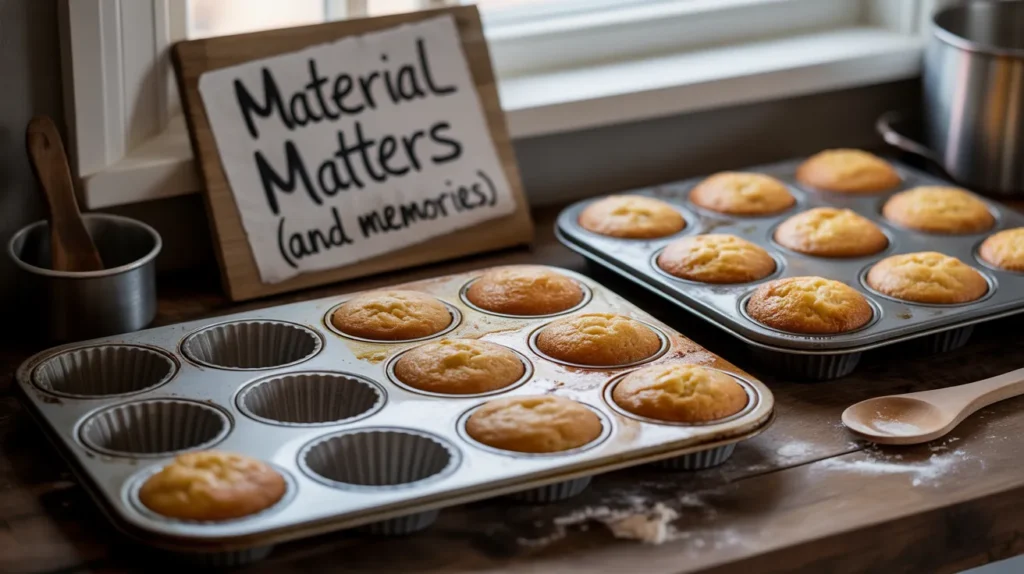
When it comes to finding the perfect muffin pan, the journey is more personal than you might expect. I’ve tested aluminum, non-stick, and silicone pans, and each one has left its mark—sometimes literally, in the form of burnt edges or muffins that stuck like glue.
The choice of muffin pan material isn’t just about what looks good on the shelf; it’s about how your muffins bake, brown, and release from the pan. Let’s break down the pros, cons, and a few stories that shaped my own search.
Aluminum: The Reliable Workhorse (with a Catch)
Aluminum pans are often the first stop for many bakers. They’re affordable, conduct heat well, and feel sturdy in the hand. I remember my first batch of blueberry muffins in an aluminum pan—they baked evenly, but getting them out was another story. Even with a generous coating of butter, a few muffins clung to the sides, refusing to budge.
Research shows that while aluminum pans offer excellent heat distribution, they can stick without liners or enough grease. If you’re aiming for even browning, aluminum delivers, but easy release isn’t always guaranteed.
Non-Stick: The Browning Champion
After a few too many stuck muffins, I switched to a non-stick muffin pan. The difference was immediate. Muffins popped out with barely a nudge, and cleanup was a breeze. But not all non-stick pans are created equal. My first was a dark-colored pan, and I quickly learned—after burning a batch or two—that lighter non-stick pans are better for even browning.
Baking experts back this up: lighter colors reflect heat, preventing over-browning and giving muffins that perfect golden top. Non-stick pans consistently outperform others for browning and release, especially when you use a medium-cup size (about 100ml), which seems to be the sweet spot for most home bakers.
Silicone: Flexible, but Fickle
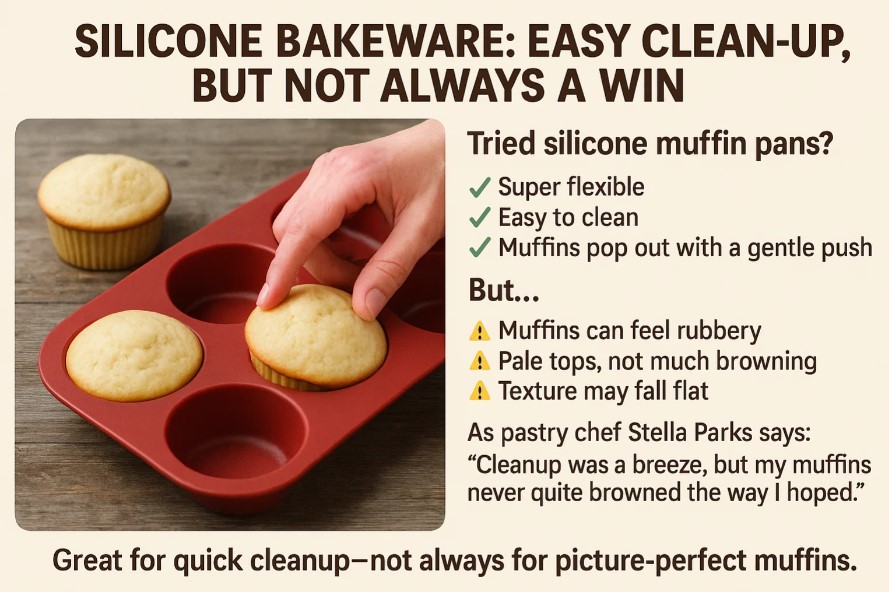
Curiosity led me to try a silicone muffin pan. The appeal? Flexibility and easy cleaning. I’ll admit, unmolding muffins was almost fun—just a gentle push and out they came. But the texture was… different. My muffins had more “personality” than flavor, with a slightly rubbery feel and pale tops that never quite browned. As Stella Parks put it,
“Silicone pans made cleanup a breeze, but my muffins never quite browned the way I hoped.”
Silicone pans are great for certain recipes and for anyone who hates scrubbing, but if you crave that classic muffin texture and color, you might want to experiment before committing.
Are Premium Brands Worth It?
After trying several pans, I started looking at premium brands. Nordic Ware and USA Pan came up again and again in reviews and recommendations. These pans are known for their durable pans and consistent performance. I found the investment worthwhile—muffins baked evenly, released easily, and the pans held up after countless uses.
Other notable brands like Stud Muffin, Anolon, and OXO also offer unique features, from reinforced rims to clever cavity placement for better muffin expansion.
| Feature | Details |
|---|---|
| Medium-cup capacity | ≈100ml is optimal for most muffin recipes |
| Lighter non-stick pans | Yield better browning than dark pans |
| Notable brands | Nordic Ware, USA Pan, Stud Muffin, Anolon, OXO |
Choosing the right muffin pan is a balance of material, color, and brand. Each type has its quirks, and sometimes, the only way to know what works for you is to bake a few batches—and maybe burn a few, too.
“A good muffin pan is like a trusted friend in the kitchen—reliable and always there when you need it.” – Julia Child
Beyond Non-Stick: The Real-World Joys and Jolts of Baking
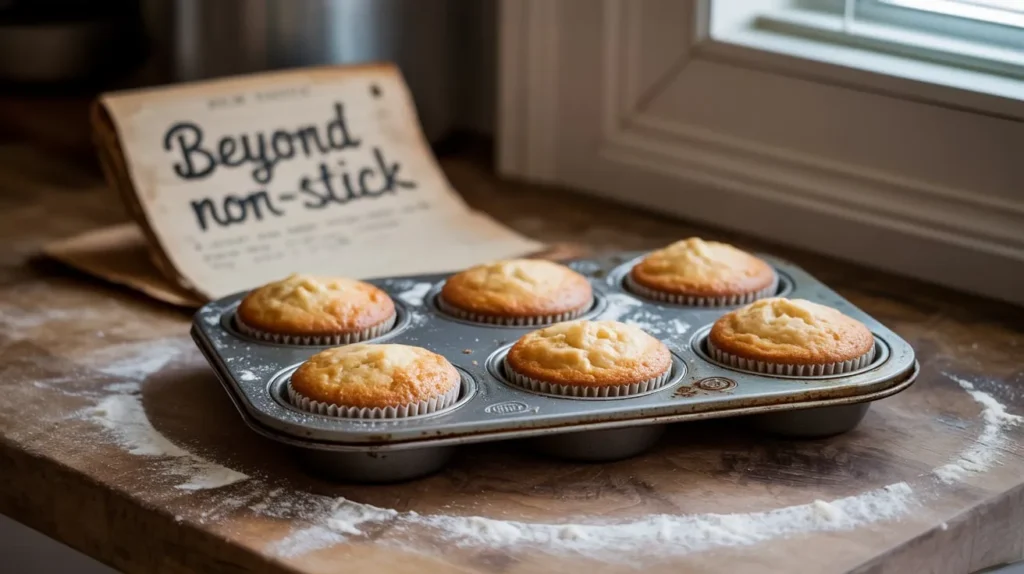
When I first started baking, I thought all muffin pans were pretty much the same. As long as the batter didn’t stick and the muffins looked decent, I was happy. But, as it turns out, the quest for the perfect non-stick muffin pan is a lot more personal—and a bit more complicated—than I expected. There’s a whole world beyond just “non-stick,” and it’s full of small joys and unexpected frustrations.
Balancing Easy Release, Even Browning, and Pan Maintenance
Let’s be honest: nothing ruins a batch of muffins faster than half of them sticking to the pan. That’s why non-stick coatings are so popular. But there’s more to it. Research shows that well-designed pans, like those from OXO, don’t just help with easy release—they also promote even browning. Lighter-colored non-stick pans, for example, tend to brown muffins more evenly than darker ones, which can over-bake the edges. It’s a subtle detail, but it makes a difference in the final result.
Of course, there’s a trade-off. Non-stick coatings are delicate. If you want your pan to last, you have to treat it gently. That means no abrasive sponges, no dishwasher, and definitely no metal utensils. I learned the hard way that a little patience with hand washing pays off. Muffin maintenance isn’t glamorous, but it’s essential if you want your favorite pan to stick around.
Why OXO’s Below-Platform Design Actually Prevents Muffin-Top Disasters
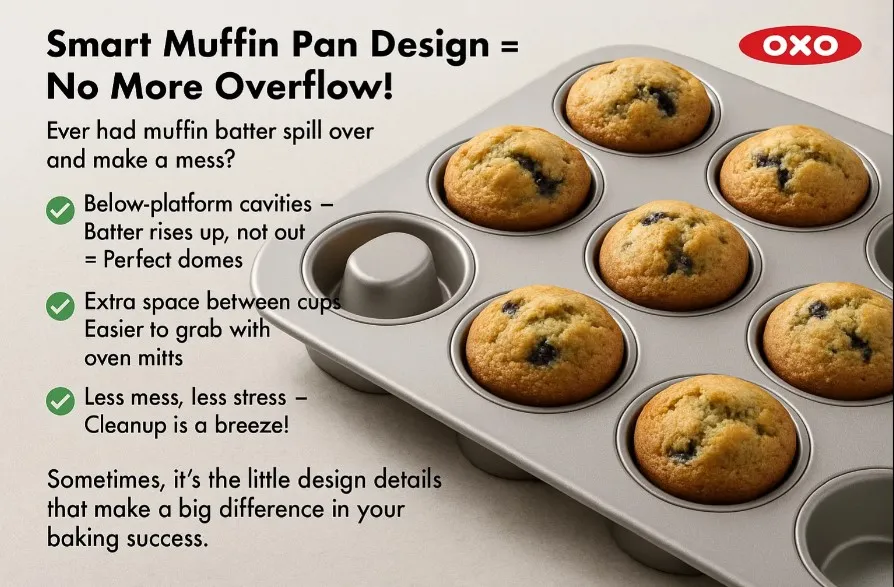
One of the biggest surprises for me was how much the design of the muffin pan itself matters. OXO’s muffin pan, for example, has cavities that sit below the main platform. At first, I didn’t think much of it. But after a few rounds of baking, I realized this design actually helps prevent muffin-top disasters. The batter has space to expand upward, not outward, so you get those classic domed tops without the dreaded spillover. It’s a small detail, but it saves a lot of cleanup—and a lot of frustration.
Another bonus: OXO pans have extra space between the cavities. That means you can grab the pan easily, even with oven mitts, and you’re less likely to squish a perfect muffin while pulling it out of the oven. It’s one of those things you don’t notice until you’ve struggled with a cramped pan from another brand.
Maintenance Hacks: Making Non-Stick Coatings Last Longer
If you want your non-stick muffin pan to last, maintenance is key. Here are a few baking tips I’ve picked up along the way:
- Always hand-wash your pan with a soft sponge and mild soap.
- Avoid using metal utensils or anything abrasive.
- Let the pan cool before washing to prevent warping.
- If you end up with a crusty pan, soak it in warm water and use a gentle brush—never steel wool.
It takes a little extra time, but it’s worth it. As Dorie Greenspan puts it:
“Baking is mostly waiting and washing up; trust me, the muffin pan you pick makes a difference.”
Quick Reference Table: Muffin Pan Care and Design
| Feature | Benefit |
|---|---|
| Hand-wash only for non-stick pans | Maintains durability and coating integrity |
| OXO’s sub-platform cavities | Allows proper muffin expansion and prevents spillover |
In the end, the right pan—and a little care—can make all the difference in your baking routine. The joys and jolts are real, but so are the perfectly baked muffins.
Hidden Costs and Worthwhile Extras: Pricing, Liners & The Occasional Muffin Fiasco
When I first started my search for the best muffin pan, I assumed it would be a simple matter of picking one off the shelf and calling it a day. But as I dug deeper into muffin reviews and compared options, I realized there’s a surprising amount of nuance—and, yes, a few hidden costs—lurking behind those shiny nonstick surfaces. If you’re like me and want to get the most out of your baking gear, it’s worth looking past the batter and into the details that really matter.
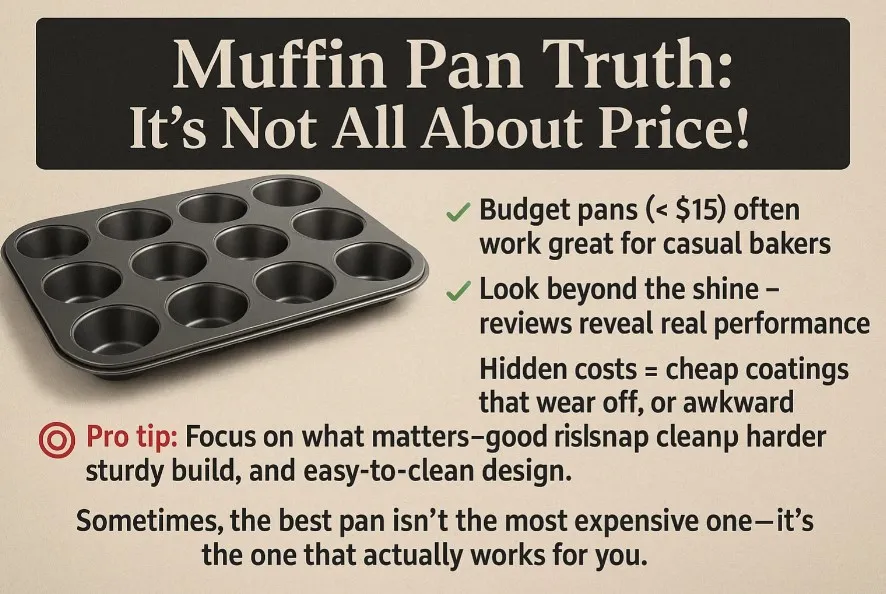
Let’s talk muffin pricing. At first glance, it’s tempting to think that the more you spend, the better your muffins will turn out. But that’s not always the case. Budget-friendly pans (usually under $15) can actually perform quite well, especially if you’re baking occasionally or just starting out.
I’ve been pleasantly surprised by some basic aluminum pans that brown evenly and release muffins with minimal fuss. Still, there’s a reason mid-range ($15–$30) and premium ($30+) pans exist. Extras like reinforced rims, ceramic coatings, and especially lids—like the one on Anolon’s pan-with-lid—can make a real difference in convenience and durability. That lid, for example, is a game-changer if you ever need to transport or store your muffins, though it does bump up the price.
Then there’s the Stud Muffin pan, which I tried after reading glowing muffin reviews. It’s not the cheapest, but the ceramic coating and wire-reinforced rims make it feel sturdy and reliable. The OXO pan, on the other hand, has cleverly designed cavities that sit below the platform, allowing muffins to expand without sticking together—a small detail, but one that makes a difference when you’re aiming for bakery-worthy results. Research shows that features like these can impact both the baking process and the final outcome, so it’s worth considering what matters most to you.
Of course, no discussion of muffin pans would be complete without mentioning liners. I used to think cupcake liners—whether paper or silicone—were just an extra step, but liner choice actually changes both how easily muffins release and how much cleanup you face afterward.
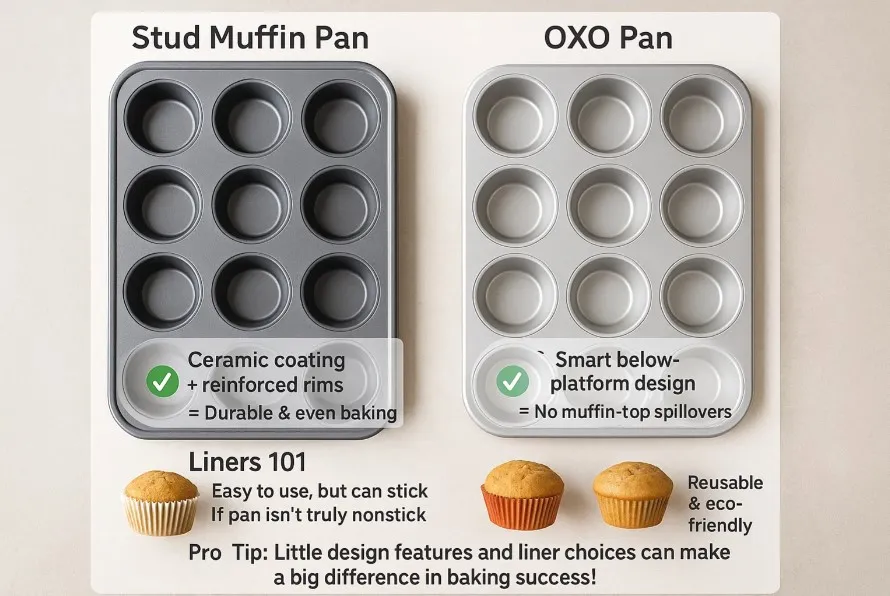
Paper liners are convenient and disposable, but sometimes stick to the muffin if the pan isn’t truly nonstick. Silicone liners are reusable and eco-friendly, but they do add to your laundry pile and can sometimes leave muffins with a slightly different texture.
Studies indicate that lighter-colored nonstick pans, paired with the right liner, yield the best browning and release results. It’s a small detail, but it can make a big difference in your baking routine.
And yes, I’ve had my share of muffin disasters. My most memorable? The time I overfilled every cup, ignored the warning signs, and ended up with a muffin “island” that fused together in the oven. As Erin McDowell wisely put it,
‘Sometimes the simplest pan does the job best—just don’t overfill!’
Lesson learned: sometimes it’s not about the fanciest pan, but about knowing its quirks and respecting its limits.
In the end, the quest for the perfect muffin pan is surprisingly personal. Whether you go for a budget buy or splurge on extras, the right choice depends on your baking style, storage needs, and how much cleanup you’re willing to do. For me, it’s about finding that sweet spot where performance, price, and practicality meet—because the best muffin pan is the one that fits your kitchen, your habits, and, occasionally, your muffin mishaps.
Picking the ideal muffin pan is less about hype and more about balance: choose material and style based on your baking habits, and don’t ignore the joy factor of removing perfect muffins every time.
Frequently Asked Questions For How to Choose the Right Muffin Pan
Can I use a cupcake pan for muffins?
Yes! Muffin and cupcake pans are usually the same. Just adjust baking times if needed.
Are silicone muffin pans worth it?
They’re great for easy release but may not brown muffins as well as metal pans.
How do I prevent muffins from sticking?
Grease the pan or use liners. Non-stick pans also help.
“Baking is a science, but the right tools make it an art.” – Mary Berry
Top Tips for Maintaining Your Muffin Pan
- Avoid metal utensils on non-stick surfaces to prevent scratches.
- Hand wash when possible to preserve the coating.
- Store properly to avoid warping or damage.
Conclusion
Choosing the right muffin pan depends on your baking style, preferred material, and pan size. Whether you opt for non-stick, stainless steel, or silicone, the best pan will make baking easier and more enjoyable.
“The secret to great muffins? A good pan, good ingredients, and a little love.” – Paul Hollywood
Now that you know how to pick the perfect muffin pan, happy baking!

